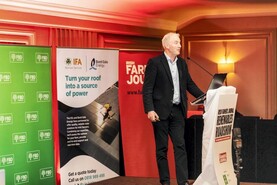Last week’s article on the potential margins attainable from finishing store lambs has generated lots of discussion.
There have been requests for more information about the budgets presented by Michael Gottstein, head of the Teagasc sheep programme.
The budgets discussed last week are detailed in Table 1 and were completed using the Teagasc store lamb finishing calculator.
The easy-to-use tool can be found on the Teagasc website and allows all sorts of permutations to be put to the test.
The user inputs data such as the date of purchase, starting weight, value of lambs, likely production costs, duration of grazing and forecast farmgate sale price.
As discussed last week, where a period of grazing can be built in, particularly where starting from a low liveweight, then the best the likelihood will be of generating a positive margin. It is important to use realistic production costs and performance targets. Many producers often forget to include costs such as transport, interest and mortality when calculating finishing budgets, but these are all very real costs that can have a significant influence.
Concentrate costs vary greatly depending on the volumes being purchased and significant savings can also be made from purchasing concentrates in bulk compared to 25kg bags. Veterinary costs will be influenced by the length of time lambs are on farm and the health programme in place.
For example, a simple protocol of a quarantine drench and footcare averages about €1.50 per head.
Including an orf vaccine and a second drench raises this to €2.80 per head, while a full course of clostridial disease vaccination will raise this to €4.90 per head.
Other expenses include aspects such as bedding and labour.
Target mortality should be below 2% to 3% but this may need to be raised in certain cases for lambs transferred indoors immediately for finishing. Gender and lamb type are important.
Performance figures
All the figures included in the calculator are based on proven performance with extensive research taking place in Mellows Campus Athenry.
The calculator works on the premise that once lambs are housed they will be transferred to an ad-lib concentrate diet.
Typical intake of hill store lambs is in the region of 1.1kg, rising to 1.2kg for crossbred lambs.
Crossbred lambs have a higher growth rate potential on an intensive finishing diet (250g/head/day), better food conversion efficiency (FCE of approximately 5:1) and superior slaughter performance compared to hill lambs. Hill lambs are still capable of achieving favourable performance (average 200g/hd/day) with a lower FCE of 6.5kg concentrates to 1kg liveweight.
Grazing period
With regard to grazing performance weather and utilisation will have a direct bearing on the potential result with grass quality laying the foundation for the level of performance, that can be achieved.
Research has shown that light hill lambs are capable of achieving compensatory performance, provided that is that lambs are healthy and transition satisfactorily to eating concentrates.
Lambs less than 25kg have managed to gain 145g per day or in excess of 10kg liveweight in a 10-week period in Athenry in recent years, while typical performance for heavier lambs on grass is an average of 100g to 110g or 7kg to 8kg gain.
Finishing period
The target carcase weight will influence the length of time lambs are on the farm.
In practice, lamb performance will need to be monitored with drafting occurring earlier where performance stagnates.
Wether and ewe lambs will typically finish faster than ram lambs and therefore drafting decisions should be based on both weight and fat cover.
The system will deliver a projected farmgate price based on historical lamb price data for the time of year. The figure can be accepted or deviated from.
The output figures are generated automatically and the producer has no role here.
In addition to the gross margin, the calculator online also delivers a breakeven carcase price, along with a breakeven purchase price and price per kilo.






 This is a subscriber-only article
This is a subscriber-only article











SHARING OPTIONS: